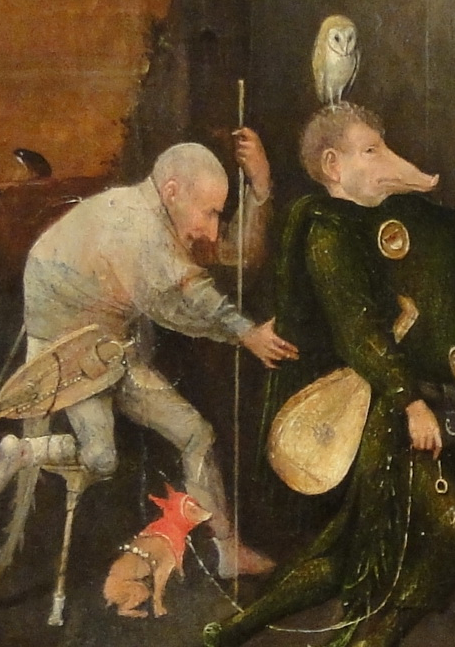[Joseph's] glory is like the firstling of his bullock, and his horns are like the horns of unicorns: with them he shall push the people together to the ends of the earth: and they are the ten thousands of Ephraim, and they are the thousands of Manasseh (Deut. 33:17).
As I have noted before, the unicorns of the King James Version is a rhinoceros in the Vulgate and a wild ox in most modern English translations. The classic wild ox, the aurochs, is now extinct, but one of its closest relatives, the wild yak (Bos mutus) still lives in the wild. As noted in "The horrible hairy homeward-hurrying hogs of Hieronymus," these three animals -- the unicorn, the rhinoceros, and the yak -- appear together on the cover of Animalia.
Note that in Deuteronomy, Joseph uses his figurative "horns" to "push the people together to the ends of the earth." This is curious phrasing -- how can they be "together" at "the ends of the earth"? -- and has been variously interpreted. The most common reading seems to be that Joseph will "push" (i.e., gore) all the nations, including even those at the ends of the earth, and that he will attack them all at once, or "together."
Today, in my regular daily scripture study, I read an allusion to this imagery in one of the revelations of Joseph Smith:
Keep these sayings, for they are true and faithful; and thou shalt magnify thine office, and push many people to Zion with songs of everlasting joy upon their heads (D&C 66:11).
Here, pushing people together means driving them together and causing them to gather in a group, as a sheepdog would do. That the "pushing" is not a violent attack is evident in the "songs of everlasting joy" upon the heads of those pushed. If the first part of the verse alludes to Deuteronomy, the second part borrows a turn of phrase from Isaiah:
Then shall the lame man leap as an hart, and the tongue of the dumb sing: for in the wilderness shall waters break out, and streams in the desert.And the parched ground shall become a pool, and the thirsty land springs of water: in the habitation of dragons, where each lay, shall be grass with reeds and rushes.And an highway shall be there, and a way, and it shall be called The way of holiness; the unclean shall not pass over it; but it shall be for those: the wayfaring men, though fools, shall not err therein.No lion shall be there, nor any ravenous beast shall go up thereon, it shall not be found there; but the redeemed shall walk there:And the ransomed of the Lord shall return, and come to Zion with songs and everlasting joy upon their heads: they shall obtain joy and gladness, and sorrow and sighing shall flee away (Isa. 35:6-10).
The tongue of the dumb shall sing. The wild yak, as mentioned above, is Bos mutus ("mute ox"), in contrast to its domestic cousin Bos grunniens ("grunting ox"). Repeated references to water -- "waters break out," "a pool," "springs of water" -- suggest that the "highway" by which the pushed-together ransomed will return is the one the Vikings called the "whale-road."
Which brings us by a commodius vicus of recirculation back to Animalia:
According to Etymonline, yodel is "from German jodeln, from dialectal German jo, an exclamation of joy." Songs of everlasting joy.
The sails of the yaks' yachts are decorated with various things beginning with Y: a Yeoman Warder in a yin-yang symbol, a yeti, an egg with a yolk, a yoke, and even another little yacht. There's also a poker hand -- Two of Hearts, Three of Diamonds, Two of Clubs, Ace of Clubs, Ace of Hearts -- whose connection to the letter Y is a mystery to me. I've looked through glossaries of poker terms and lists of card games but can't find anything beginning with that letter.
Notice that if you go straight down from the egg, you will find a yo-yo. In "Leo, Egbert, Peter," I posted this photo of the shoe shelves at my school.
I was focused on the three names in the post title, but a commenter (whose name happens to be extremely close to Leo Egbert) asked about the lower shelf. Only one name is visible there but isn't very legible in the photo. He thought it might be Sarah, but in fact it's Ivan. The name directly below Egbert is obscured by a pair of slippers, but it's this:
Quite a few kids in Taiwan use Yoyo as their "English" name; I blame that cellist. In the William Wright post that led to my posting photos of shoe shelves in the first place, he interpreted Egbert as meaning "famous egg" and connected it with Humpty Dumpty -- famous as a broken egg that can't be put back together. On the Y page, we have a broken egg above a yo-yo. I suppose the yoke between them even suggests the heel ends of a pair of slippers.
Besides the poker hand, one other element in the picture puzzled me because of its lack of any obvious connection to the letter Y:
This is a reference back to "The Gospel of Luke on lobsterback," keeping in mind that the Gospel of Luke is symbolized by the ox or bull (or yak, same difference). The Beefeater on the sail, dressed in red, is a link to the other meaning of lobsterback, a red-coated British soldier.





















